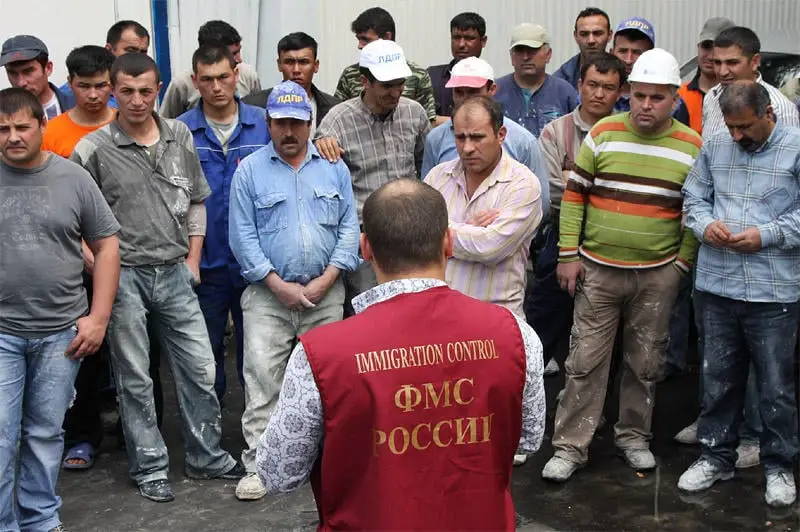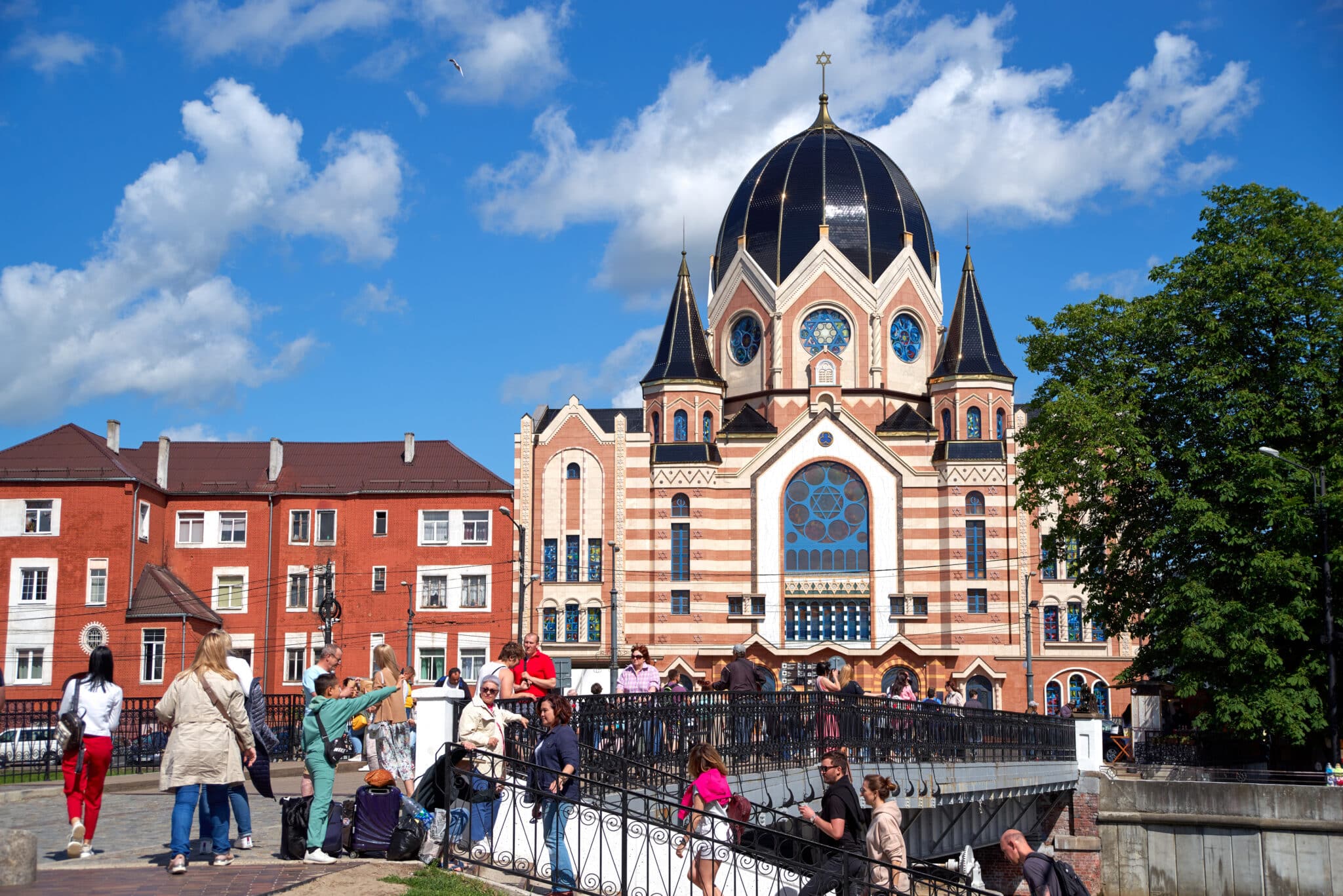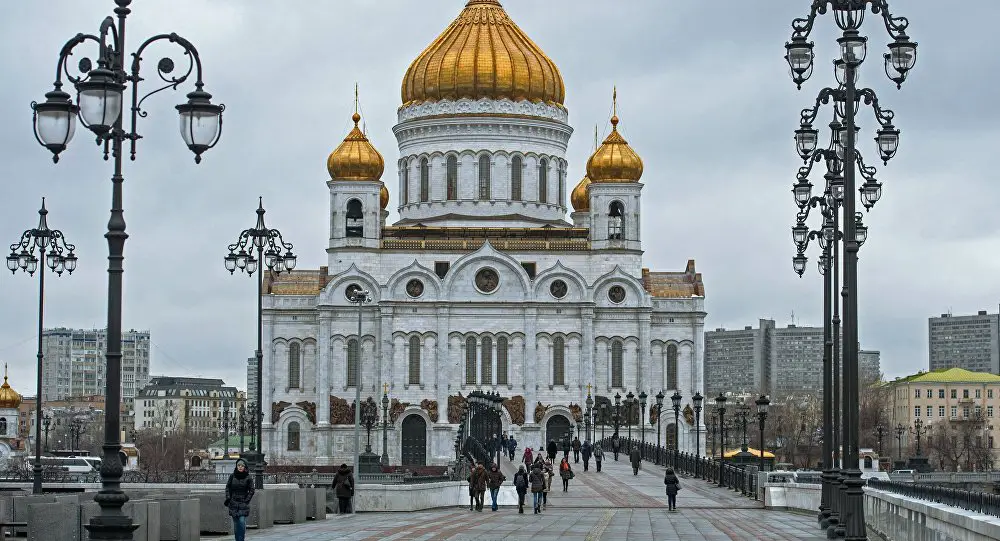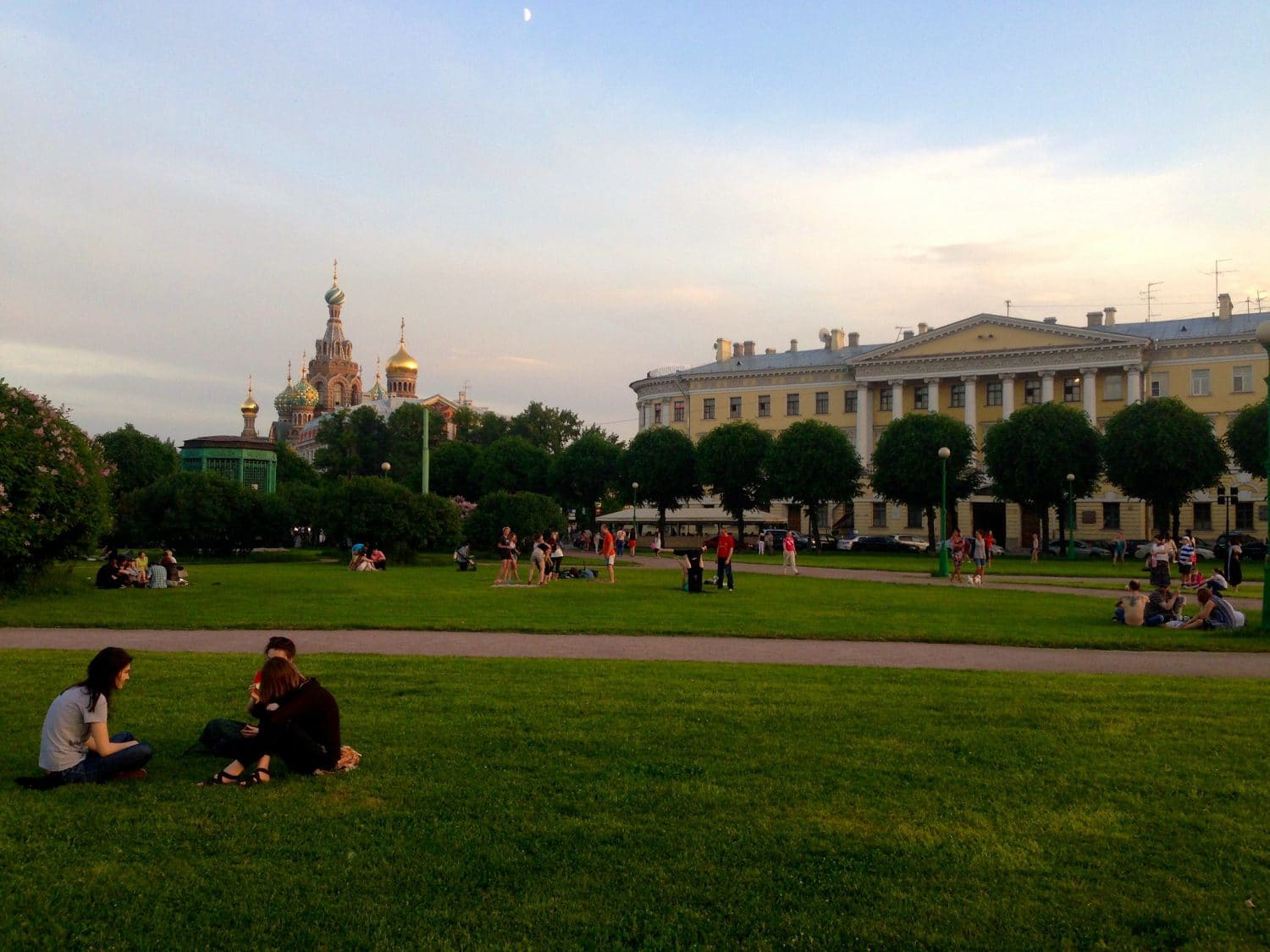In this text, Tajik blogger Roxana Burkhanova describes, in Russian, the history of Jews in the Russian Empire, the USSR, and the Russian Federation. While the resource focuses on Russia, this also includes Jews in regions which are no longer part of Russia – including Central Asia, the Caucasus, and Central and Eastern Europe. More on these Jews can also be found in our Guides to Jewish Places on this site including for Georgia, Poland, Latvia, and Kyrgyzstan.
The resource below is part of a larger series of intermediate Russian lessons known as Моя Россия, in which Roxana explores minority populations in Russia as well as economic and demographic issues there. Моя Россия builds upon Olga’s Blog, another set of intermediate Russian lessons that give shorter texts that focus more on daily life and cultural issues. All of these lessons have been sponsored by SRAS, an organization that encourages the study of Eurasia from abroad through free resources and offers study abroad programs in Eurasia.
We will start with a brief synopsis in English before presenting the Russian text. As the Russian text was originally written in 2016, we have also provided a small update in English to the information presented there. All boldface words are vocabulary words that are defined and discussed below. All words marked in red are part of the grammar lesson included below that.
Jews and Judaism in Russia and the USSR – Synopsis and Update in English
Jewish presence in Russia dates back to antiquity in regions like the Bosporan Kingdom and the Khazar Khanate. Over time, there have been various types of Jews in Russia: Ashkenazis, Mountain Jews, Georgian Jews, Bukharan Jews, Karaites, and Krymchaks. Each type has their own culture and, often, speaks their own language as well. Many have been native to their various lands for hundreds and hundreds of years.
Jewish history in Russia was particularly impacted in the 18th century with the partitions of Poland. A very large number of Jews were absorbed into the Russian Empire with the Polish lands. This coincided with a rise in antisemitism across Europe. There were soon mass pogroms in the Russian empire between 1881 and 1906, followed by emigration waves, especially to the USA.

Jewish thinkers and leaders played leading roles in the Russian revolutions. Despite that, they soon faced rising antisemitism (often masked as “anti-cosmopolitanism”) in the USSR. During WWII, an estimated 1.5 to 2 million Soviet Jews were killed by the invading Nazis as part of the Holocaust. Afterward, with diminished representation and continued discrimination, many Soviet Jews Russified, seldom speaking Yiddish or attending synagogues. Many families effectively lost their identities. However, because being “Jewish” is both an ethnicity and religious affiliation, even Jews who tried to Russify were still identified as ethnically Jewish and treated as such.
Jewish emigration to Israel increased in the 1970s, boosted first by Israel’s creation and later by the Six-Day War. During perestroika, economic hardship, political uncertainty, a resurgence of national identity, and fears of renewed antisemitic pogroms spurred interest in emigration to Israel, leading to the departure of over a million Jews between 1989 and 2004.
In the 2000s, the international Jewish community lead efforts to revive the Jewish faith among ethnic Jews who remained in Russia. The Russian state has also consistently maintained support for “traditional religions” in Russia, which includes Judaism. The state has supported renovating synagogues, including those that were returned to use as Jewish institutions after being confiscated and repurposed by the Soviet authorities. There was even some re-immigration of Jews that had previous left.
However, since this lesson was originally written in 2016, Russia’s Jewish population has fallen again. Russia’s 2010 census recorded about 160,000 ethnic Jews. The 2021 census recorded about half that. Since 2022, many people, especially young people, have emigrated from Russia following the start of the war in Ukraine. While there are no hard numbers of how many of these people are Jewish, Israel recorded about 40,000 Russian immigrants in 2022 – although most likely not all of those are Jews.
Религия в России – Иудаизм
История иудаизма в России неразрывно связана с историей российского еврейства, так как евреи – это не только этническая, культурная, но и религиозная группа. Большинство евреев в российской истории были иудеями. Когда же они иудеями не были (а были, к примеру, атеистами или православными), их или считали таковыми, или считали просто евреями, все еще другими, иными, но уже не столь чуждыми. Именно на этом восприятии основывается длительная история не только еврейства в России, но и русского антисемитизма. В данном уроке я буду говорить не только о евреях на территории современной России, но и о евреях на тех территориях, которые когда-либо входили в Российское государство и Советский Союз.
Кстати, история российского иудаизма связана с несколькими группами евреев. Большинство из них – это ашкеназы (их язык – идиш), а также горские евреи (говорят на татском), грузинские евреи (они общаются на еврейско-грузинском языке), бухарские евреи (говорят на диалекте таджикского языка), караимы и крымчаки (в основном общаются на русском языке).
История евреев в России, их приход и уход
На территории современной России иудаизм существовал в Боспорском царстве (берега Черного и Азовского моря) и в Хазарском каганате (от берегов Черного до территорий восточнее Каспийского моря) еще в античные времена. Несмотря на то, что существуют свидетельства о существовании некоторых еврейских общин в Киеве и Чернигове в 10-11 веках, основная история еврейства в России начинается в 18 веке, после разделов Речи Посполитой. Именно на этих новых территориях, присоединенных к Российской Империи в 1772, 1793, 1795-х годах и проживало большое количество евреев. Так что к концу 19 века в Российская Империя была государством с самым большим в мире еврейским населением (67% всех евреев мира в 1880 году проживало в России). Однако эта ситуация довольно быстро поменялась после массовых погромов с 1881 по 1906 год, в которых пострадало большое количество евреев, а затем и после Первой мировой и Гражданской войны. К концу первой четверти 20 века Российское государство покинуло примерно 2 миллиона евреев, отправившись преимущественно в США. Во времена Холокоста на территории СССР от 1,5 до 2 миллионов евреев стало жертвами геноцида, совершенного нацистами и их пособниками.

Пережив Великую Отечественную Войну, многие евреи поселились в больших городах и постепенно обрусели, мало кто говорил на идише или посещал синагоги. А затем еврейское общество ожидал еще один удар: несмотря на в целом положительное и нейтральное отношение к самим евреям до войны, в СССР началась «борьба с космополитизмом», главной жертвой которого стали именно евреи. В стране развернулась целая кампания против них, а также против еврейских организаций и обществ. Закрывались синагоги, еврейские культурные учреждения. Поговаривали о личной крайней неприязни Сталина к евреям, в результате которой был придуман целый американо-сионистский заговор, якобы направленный против него. Многие видные лица еврейской национальности были обвинены в работе на американскую разведку, затем арестованы и казнены.
70е годы – это годы активнейшей эмиграции советских евреев в Израиль. Сначала создание государства Израиль в 1948 году, а затем в особенности Шестидневная война в 1967 году повлияли на поднятие национального самосознания среди советского еврейства. Советским правительством было решено разрешить евреям эмигрировать в Израиль. За 6 лет, с 1969 по 1975 год, примерно 100 тысяч евреев Советского Союза эмигрировали. Однако уже в конце 80-х интерес к Израилю несколько спал, все более популярным направлением становилась Америка.
Годы перестройки активно сопровождались ростом национального самосознания, а также национализма всех народов СССР. Последнее стало причиной множественных страхов и слухов о еврейских погромах, что привело к очередному росту интереса к жизни в Израиле среди советских, а затем уже и российских евреев. В период с 1989 по 2004 год более миллиона человек переселилось в Израиль (часть из них – супруги, не являющиеся евреями, а также люди с еврейскими корнями). Этот процесс переселения евреев в Израиль называется алия.
Характер расселения
Стоит отметить некоторые особенности жизни российских евреев. До 20 века довольно много евреев проживало в местечках (небольших городах, так как в сельской местности жить иудеям было нельзя) отдельными общинами, которые не поддавались активной ассимиляции. Много подобных населенных пунктов состояло практически только из еврейского населения, однако были города и со смешанным населением, в которых евреи селились близко друг к другу.
Более того, существовала особая черта оседлости. Это была территория в западных губерниях Российской Империи, за пределами которых селиться иудеям было категорически запрещено. Территория была определена во времена второго раздела Польши, в 1791 году. К концу 19 века лишь 200 тысяч иудеев из общего числа (5 миллионов) получили право проживать за пределами черты оседлости. Единственным реальным путем из западных губерний в центральные был «выкрест» – переход иудеев в православие. И хотя эта практика активно поощрялась, а все жесткие ограничения с таких людей снимались, им порой активно припоминали их еврейское прошлое или их еврейские корни. В 1915 году черту оседлости упразднили, а в 20 веке евреи в основном стали жить в больших городах.
Религия

Как видите, отделить историю евреев от истории иудаизма в России невозможно. Однако на протяжении российской истории не были редкими случаи перехода евреев из иудаизма в православие (тот самый «выкрест»), как и переходы прочих народов из христианства в иудаизм (хотя эта практика была категорически запрещена). В начале 20 века участились случаи, когда евреи отходили от традиций иудаизма. Ярким примером подобного являлась Еврейская секция партии большевиков, в которой состояли евреи-атеисты, борющиеся с раввинами и иудаизмом. С 1918 года в СССР многие синагоги были закрыты, раввины арестованы и расстреляны, а иврит, священный язык, был под запретом аж до 1988 года.
Но, подобно многим другим религиозным конфессиям России, иудаизм переживает расцвет с 1992 года: строятся новые синагоги, восстанавливаются старые. Сейчас в России несколько общероссийских сетей организации иудеев, которые связывают себя с иудаизмом как в религиозном, так и в культурном смысле. Главных раввина в стране два. Многие широко известные в России люди спонсируют еврейские организации (Роман Абрамович) и принимают участие в их деятельности (Иосиф Кобзон).
Роль евреев в Российской истории
Евреи оставили яркий след в российской истории. Они были активными участниками революций начала 20 века (значительной частью большевиков были или люди еврейского происхождения, или евреи), активно боролись с монархической властью и за равноправие (как свое, так и других групп населения). Среди евреев и их потомков было огромное количество известных культурных деятелей, писателей, поэтов, художников, артистов, актеров, врачей, ученых: Николай и Антон Рубинштейны, Исаак Левитан, Леонид Утесов, Самуил Маршак, Лев Ландау, Борис Пастернак и многие другие.
И даже сейчас довольно много осталось мест, заброшенных пустырей, которые раньше были частью еврейского мира в России и о которых остались лишь напоминания в виде старых заброшенных еврейских кладбищ, топографических названий, старых архивных записей.
В следующем уроке мы рассмотрим историю религий в советское время.
Vocabulary and Cultural Annotations
Иудей – Jew (by religion)
Еврей – Jew (by ethnicity/culture)
Еврейство – Jewry
антисемитизм – antisemitism
Ашкеназы – Ashkenazi Jews
Идиш – Yiddish
Горские евреи – Mountain Jews or Caucasus Jews also known as Juhuro, Juvuro, Kavkazi Jews or Gorsky Jews; are Jews of the eastern and northern slopes of Caucasus, mainly Azerbaijan and Dagestan. They are the descendants of Persian Jews from Iran.
Татский язык – The Tat Language or Judeo-Tat.
Грузинские евреи – Georgian Jews (the country of Georgia in the Caucasus). Jews are one of the oldest religious communities in Georgia, tracing their original migration into the country from the Babylonian captivity in 6th century BC.
Бухарские евреи – Bukharan Jews (also Bukharian Jews or Bukhari Jews) are Jews from Central Asia who historically spoke Bukhori, a dialect of the Tajik-Persian language.
Таджикский язык – Tajik language.
Караимы – The Crimean Karaites or Krymkaraylar; an ethnic group derived from Turkic-speaking adherents of Karaism in Eastern Europe, especially in the territory of the former Russian Empire. Some regard them as descendants of Karaite Jews who settled in Crimea. Others view them as descendants of Khazar or Cuman, Kipchak converts to Karaite Judaism.
Крымчаки – Jewish ethno-religious communities of Crimea derived from Turkic-speaking adherents of Orthodox Judaism.
Боспорское царство – The Bosporan Kingdom (438 BC – 370 AD), was an ancient state located in eastern Crimea and the Taman Peninsula on the shores of the Cimmerian Bosporus, the present-day Strait of Kerch.
Хазарский каганат – Khazar Khanate or Khazaria (650-1048); one of the foremost trading emporia of the medieval world, commanding the western marches of the Silk Road and playing a key commercial role as a crossroad between China, the Middle East and Kievan Rus’.
Погром – pogrom; a violent riot aimed at the massacre or persecution of an ethnic or religious group, particularly one aimed at Jews. The term originally entered the English language in order to describe 19th- and 20th-century attacks on Jews in the Russian Empire.
Речь Посполитая – Polish–Lithuanian Commonwealth or Rzeczpospolita (a traditional and official name of the Polish State). Rzeczpospolita I, II and III existed (1569-1795, 1918-1939, 1989 – present).
Холокост – The Holocaust; A genocide in which Adolf Hitler’s Nazi Germany and its collaborators killed about six million Jews (Холокост) and millions more gays, communists, Roma, and other targeted groups.
Пособник – accomplice, collaborator.
Обрусеть – to become Russian by adopting the Russian culture, language, and traditions.
Космополитизм – cosmopolitanism; in USSR cosmopolitans were intellectuals who were accused of expressing pro-Western feelings and of lacking patriotism. The term “rootless cosmopolitan” typically referred to Jewish intellectuals after it first appeared in a Pravda article condemning a group of theatrical critics. However, the term was originally coined by the Russian nineteenth-century literary critic Vissarion Belinsky to describe writers who lacked national character.
Синагога – synagogue.
Сионизм – Zionism; a nationalist political movement of Jews and Jewish culture that supports the re-establishment of a Jewish homeland in the territory defined as the historic Land of Israel (roughly corresponding to Palestine, Canaan or the Holy Land).
Заговор – conspiracy, plot.
Разведка – intelligence / secret service.
Шестидневная война – Six-Day War; also known as the June War, 1967 Arab–Israeli War, or Third Arab–Israeli War, was fought between June 5 and 10, 1967 by Israel and the neighboring states of Egypt (known at the time as the United Arab Republic), Jordan, and Syria.
Национальное самосознание – national identity; mostly means one’s identity or sense of belonging to one state or to one nation. In Russian, in generally means both citizenship and ethnic affiliation.
Национализм – nationalism; a feeling of patriotism, often an extreme form that places one’s own nation (ethnicity) above others.
Еврейские корни – Jewish roots; I used this expression to underline the difference between Jews and those people whose ancestors, parents, grandparents were Jews. These people may consider themselves to be non-Jewish, or Jewish, or mixed.
Алия – Aliyah – is the immigration of Jews from the diaspora to the Land of Israel (Eretz Israel in Hebrew). The State of Israel’s Law of Return gives Jews and their descendants automatic rights regarding residency and Israeli citizenship.
Местечко – this was a type of a small town in Rzeczpospolita (modern Belarus, Lithuania, Latvia, Poland, Ukraine and Western Russia) often mostly inhabited by Jews.
Черта оседлости – Pale of Settlement; it was a western region of Imperial Russia, in which permanent residency by Jews was allowed and beyond which Jewish permanent residency was generally prohibited. Jews were excluded from residency at a number of cities within the Pale, while a limited number of categories of Jews were allowed to live outside it. Pale was acquired by the Russian Empire (which was majority Russian Orthodox) in a series of military conquests and diplomatic maneuvers between 1791 and 1835, and lasted until the fall of the Russian Empire in 1917. It comprised about 20% of the territory of European Russia and largely corresponded to historical borders of the former Polish–Lithuanian Commonwealth and the Crimean Khanate; it included much of present-day Lithuania, Belarus, Poland, Moldova, Latvia, Ukraine, and parts of western Russia. The Pale was first created by Catherine the Great in 1791.
Губерния – A governorate/guberniya was a major and principal administrative subdivision of the Russian Empire. The term is usually translated as government, governorate, or province. A governorate was ruled by a governor (губернатор, gubernator).
Выкрест – to leave one religion for another; in this case the rejection of Judaism and adoption of Orthodoxy.
Упразднить – to abolish, cancel.
Большевик – The Bolsheviks, originally also Bolshevists; they were a faction of the Marxist Russian Social Democratic Labour Party which split apart from the Menshevik faction at the Second Party Congress in 1903.
Раввин – Rabbi; is a teacher of the Torah. This title derives from the Hebrew word meaning “My Master,” which is the way a student would address a master of Torah.
Иврит – Hebrew language.
Заброшенный – abandoned, deserted; neglected.
Пустырь – wasteland.
Grammar Focus:
Marking adverbials with commas
Verbal adverbs and phrases with verbal adverbs
An adverbial is a member of a sentence that more fully describes an action or other adverbial.
1. Phrases with verbal adverbs are marked with commas no matter where they are in the sentence – before of after participle.
Ex.: Пропев по конца песню, раненые начали петь ее сначала.
Голубь, увидев детей, взлетел вверх.
Он что-то писал, наклонив голову.
2. Two or more verbal adverbs that are similar (depend on one verb and answer to the same question) are also marked with commas.
!!!Note!!! that they also work as similar members of a sentence, so commas between them should be used as with other similar members of a sentence.
Ex.: Печь, гудя и потрескивая, быстро нагревала комнату.
3. Singular verbal adverb can also be marked with commas if it didn’t lose it verbal meaning: it indicates time of a defined predicate (an action happened when something else happened), reason (an action happened because something happened), condition (action happened only if something happened). Usually such a verbal adverb is situated before predicate.
Ex.: Проснувшись, он вспомнил сразу же вчерашний вечер.
(вспомнил когда что делал? – когда проснулся)
!!!Note!!! If verbal adverb or a phrase with verbal adverb is situated after a conjunction then usually you have to put a comma between them as verbal adverb or a phrase can be separated from conjunction and placed in another part of the sentence.
Ex.: Птица вспорхнула и, задевая воду крылом, полетела на другой берег.
Птица вспорхнула и полетела на другой берег, задевая воду крылом.
Они так спешили, что, боясь опоздать, едва не забыли билеты на поезд.
Они так спешили, что едва не забыли билеты на поезд, боясь опоздать.
!!!Note!!! If conjunction «и» connects two verbal adverbs/phases with verbal adverbs that are at the same time two similar members of a sentence then there will be no comma separating them.
Ex.: Мальчик, наклонив голову и шевеля губами, что-то внимательно читал.
!!!Note!!! The conjunction «и» can be situated between two verbal adverbs/phrases and connect not them but two predicates or two clauses in one complex sentence. In this case there will be commas before and after the conjunction.
Ex.: [На фронте шли незатухающие бои], и, [сидя в классе за учебным столом, он мучительно тосковал по фронту].
[1 clause], и [2 clause]
Эти птицы только дремлют, не закладывая головы под крыло, и, заметив опасность, будят криком своих товарищей.
(дремлют как? – не закладывая головы под крыло
(будят когда? – заметив опасность)
!!!Note!!! If there’s a word «который» in a phrase with verbal adverb then it won’t be separated from verbal adverb by a comma (there will be only one comma before a phrase with verbal adverb and no after it – before or after the word «который»).
Ex.: Вот результаты эксперимента, проведя который я был удивлен.
!!!Note!!! Phrases with words «смотря по», «начиная с», «исходя из» are not phrases with verbal adverbs if you can take out «смотря», «начиная», «исходя» and the meaning will be the same.
Ex.: [Начиная] с вечера шел сильный снег.
Examples from Literature
Бричка, въехавши на двор, остановилась перед небольшим домиком, который за темнотою трудно было рассмотреть. (Н.В. Гоголь «Мертвые души»)
Была в нем одна лишь черта, которая во всех классах гимназии, [начиная] с низшего и даже до высших, возбуждала в его товарищах постоянное желание подтрунить над ним, но не из злобной насмешки, а потому, что это было им весело. (Ф.М. Достоевский, «Братья Карамазовы»)
Из Туретчины привел он жену – маленькую, закутанную в шаль женщину. Она прятала лицо, редко показывая тоскующие одичалые глаза. (М.А. Шолохов, «Тихий Дон»)
You’ll Also Love

Моя Россия 1: Гости и приезжающиe
The following is lesson 1 of the Моя Россия advanced Russian lesson series. Note that all bold words and phrases have annotation below. Red words and phrases indicate the subject of this blog entry’s grammar lesson. Asterisks indicate slang. Меня зовут Роксана. Мне 23 года, и уже много лет я живу в Москве. Большую часть […]

Judaism in Russia: Моя Россия Blog
In this text, Tajik blogger Roxana Burkhanova describes, in Russian, the history of Jews in the Russian Empire, the USSR, and the Russian Federation. While the resource focuses on Russia, this also includes Jews in regions which are no longer part of Russia – including Central Asia, the Caucasus, and Central and Eastern Europe. More […]

Islam in Russia: Моя Россия Blog
In this text, Tajik blogger Roxana Burkhanova describes, in Russian, the history and current status of Muslims in Russia. Islam is the largest minority faith in Russia and Muslims are a growing and important demographic there, especially among immigrants from Central Asia. The material below details both the challenges that Muslims have faced in integrating […]

Religion in the USSR: Моя Россия Blog
In this text, Tajik blogger Roxana Burkhanova describes, in Russian, the history and religions under the USSR. Despite the state’s officially athiestic policies, multiple religions existed within the USSR. Since that empire’s demise, all of those religions are now experiencing a revival. The material below details how this came to pass. This is part of […]

Off to Petersburg, Russia’s Cultural Capital: Моя Россия Blog
Below, Tajik blogger Roxana Burkhanova describes, in Russian, the place of St. Petersburg in Russian culture. She discusses the city’s history as well as its literary heritage, its nightlife, and even how people from Petersburg speak their own, slightly different dialect of Russian. The text was originally written in 2015 and thus references times before […]





